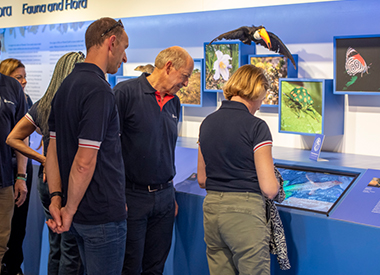Mining will continue to play an instrumental role in the development of the modern world as a growing global population demands more mined products than ever before.
But, along with the many benefits it brings to society, mining can also have a negative impact on the physical and biophysical landscape, and serious societal issues can arise when mines are not closed responsibly as employment there comes to an end.
We believe that closure and post-closure planning should be built into the full lifecycle of an asset; reviewed regularly throughout a mine’s lifecycle; incorporated into the way we plan our operating approach; how we execute during the operational phase, and then also during the post-mining phase.
Our comprehensive regenerative approach to mine closure allows us to explore opportunities, focused on economic diversification and embracing nature-based solutions and circularity principles, that will help deliver enduring value to host communities.
This regenerative approach to post-mine land use (PMLU) will enable a self-sustaining and acceptable PMLU to be established that can deliver diverse and tangible societal value to help reduce dependence on mining, even in some cases while mines are still operational, while also assisting in minimising closure and post closure liabilities.
Delivering better-informed decision making
To help deliver better-informed decision making in relation to PMLU planning, we have developed a PMLU Ecosystem model, which was piloted and enhanced at our Amandelbult platinum group metals (PGMs) mine, located in Limpopo province, South Africa.
The model is based on the delivery of five value streams that, combined, identify and prioritise projects and initiatives that aim to maximise the cumulative value for an operation and its stakeholders.
These projects will now go into the next phase to establish whether they are technically and financially viable, prior to future consultation and collaboration with stakeholders.
The aspirational desired outcomes for each value stream include:
- Social – enabling resilient communities by creating alternative livelihood opportunities resulting from different value streams.
- Water – defining sustainable water resource use in terms of quantity and quality, and minimising water pollution and our own water use, thereby allowing water availability for other users and projects.
- Land and nature – reducing current and future disturbance left by our footprint, while increasing ecosystem services that promote conservation, sustainable use and rehabilitation in an equitable way.
- Mineral and non-mineral waste – driving a reduction in mineral and non-mineral waste through re-use, recycle, beneficiation, and/or repurposing.
- Energy and carbon – implementing projects that secure clean, renewable energy for the community, and/or capture carbon through technology, nature and mineralisation.
Amandelbult – delivering a vision for closure and post-mining land use
Our Amandelbult PGMs mine is in the Thabazimbi local municipality, which has high unemployment, and where almost 30% of residents live in informal dwellings and nearly 20% of households are without access to a formal source of water.
The mine is the major employer in the area; it has a workforce of more than 10,000, most of whom are permanent employees from Thabazimbi.
Although Amandelbult’s end of life is currently planned for 2048, the PMLU Ecosystem model was piloted there in 2024 to better understand the best mix of potential PMLU plans that could be developed in collaboration with host communities and in partnership with local and national stakeholders, aiming to deliver a safe, stable and non-polluting post-mining landscape.
The goal is that self-sustaining PMLUs will help to provide alternative livelihoods and ventures to offset the expected adverse effects of mine closure on the local economy.
The initial PMLU scenario identified as being potentially the most valuable to local stakeholders included a combination of a mixed agriculture with possible downstream processing and commercial opportunities.
In addition, the scenario included the possible expansion of the current nature reserve project within the PMLU to attract external visitors, and the creation of a 300 hectare solar PV project.
We are now looking to provide training on the use of the PMLU Ecosystem model across Anglo American, with the intention to improve full-impact decision making.
Going forward, the Amandelbult team will use the pilot findings and test the viability of the initial projects identified as part of the PMLU plan.




